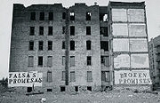
Urban decay
Urban decay is a process by which a city or a part of a city falls in to a state of disrepair. Signs of urban decay include population loss, housing stock deterioration and increases in crime.
Sourced
- I came up with Detroit. (Sorry, sports fans.) Vast stretches of the city are already uninhabited, crumbling. The central temples, yes, are still in use — the temples for sports, conventions and ritualistic music concerts — but for how much longer? Will the beautiful deco buildings erected as working shrines by what were once the largest companies in the world (GM, Ford) soon be abandoned? They’re already surrounded by a no man’s wasteland; it seems only a matter of time. And then how long before people wander into that zone and ask themselves, “Who built this incredible building?
- David Byrne
- Most of you are afraid of our neighborhood.
But did you know? So are we.
But we are here, you see,
Not because we want to be.- Anonymous, posted on a building at Cabrini-Green, a Chicago public housing complex, 1981.
- The construction of the Gowanus Parkway, laying a concrete slab on top of lively, bustling Third Avenue, buried the avenue in shadow, and when the parkway was completed, the avenue was cast forever into darkness and gloom, and its bustle and life were forever gone.
- Robert A. Caro, The Power Broker: Robert Moses and the Fall of New York 1974. Page 522.
- We [The banks] determine who will succeed and who will fail.
- John Bunting, of First Pennsylvania Bank and Trust, November 8, 1976 at the testimony of Ronald Shiffman before the New York City Commission on Human Rights, in reference to redlining.
- Money spent is money not lost via inflation.
- Jeremy Blake Roach, Social Critic, Pantheist, and Hard-Determinist.
